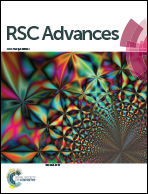High thermal and electrochemical stability of a SiO2 nanoparticle hybird–polyether cross-linked membrane for safety reinforced lithium-ion batteries†
Abstract
A phenolic-resin cross-linked polyoxyethylene (PEO) network (named NX) was synthesized to simultaneously act as both the separator and gel-polymer electrolyte in a lithium ion battery (LIB). To improve the rate performance, as well as the thermal and electrochemical stability, SiO2 nanoparticles with a diameter of 40 nm were hybridized with the above polymer (named NX-S). SEM images confirm that the surfaces of both the NX and NX-S membranes are nonporous, as compared to the porous surfaces of commercial separators. In addition, the hybrid composite has higher thermal and electrochemical stability up to 400 °C and 5 V, respectively, and higher electrolyte compatibility than the pristine NX polymer. For battery application, a high-rate performance test demonstrates that the specific half-cell capacities of the NX-S cell composed of the NX-S membrane are all higher than those of the aforementioned NX separator. Moreover, the NX-S membrane fabrication process is very simple and low cost.


 Please wait while we load your content...
Please wait while we load your content...